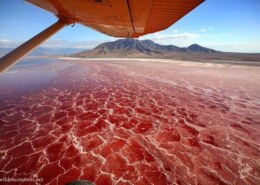Lake Natron is a highly unique and fascinating body of water located in northern Tanzania, near the border with Kenya. It is known as one of the deadliest bodies of water in Africa due to its extremely high pH levels and high concentration of minerals.
One of the most striking features of Lake Natron is its color. The lake appears to be a bright, almost fluorescent red color, which is caused by the presence of a type of algae called spirulina. This algae is able to thrive in the highly alkaline conditions of the lake, where the pH levels can reach as high as 10.5. The algae gives the lake its distinctive color and also provides an important source of food for the lake’s flamingo population.
The flamingos of Lake Natron are one of the most well-known and iconic species found in the region. They are drawn to the lake’s shallow, salty waters, which provide an ideal breeding ground for the birds. The flamingos are able to tolerate the high alkalinity of the water and have adapted to the harsh conditions by developing specialized filters in their beaks to extract food from the water.
Despite the apparent deadliness of the lake, the flamingos of Lake Natron are able to thrive, and the lake plays an important role in the local ecosystem. The algae and other microorganisms that live in the lake provide an important source of food for other species, and the lake’s unique geology and chemistry have created a highly specialized ecosystem.
However, despite its ecological importance, Lake Natron is not a popular destination for tourists. The inhospitable environment, high temperatures, and high alkalinity of the water make it a challenging and potentially dangerous place to visit. Visitors are advised to take precautions when visiting the lake, including wearing protective clothing and avoiding contact with the water.
The lake’s high pH levels and mineral content also make it a challenging environment for most forms of aquatic life. Few species are able to survive in such extreme conditions, and those that do must be highly adapted to the lake’s unique chemistry. This has led to the development of several highly specialized species that are found nowhere else in the world.
Lake Natron’s unique chemistry and geology are the result of a combination of factors, including its location in the Great Rift Valley and its lack of an outlet to the sea. The lake is fed by a number of hot springs and streams that bring in minerals and other nutrients, but there is no outlet to carry these substances away. As a result, the lake becomes increasingly salty and alkaline over time.
Despite the harshness of its environment, Lake Natron is a fascinating and beautiful place, and it has recently gained attention from photographers and nature enthusiasts who are drawn to its unique beauty. The lake’s red color and stark, otherworldly landscape have made it a popular subject for photography, and its unique geology and ecology have led to a growing interest in the scientific community.
However, the lake’s future is uncertain. The construction of dams and other water projects in the region could disrupt the natural flow of water into the lake, potentially altering its chemistry and ecology. Additionally, climate change and other environmental factors could have unknown effects on the lake and its inhabitants.
In conclusion, Lake Natron is a highly unique and fascinating body of water that is known as one of the deadliest bodies of water in Africa. Despite its harsh environment, the lake is home to a variety of highly specialized species and plays an important role in the local ecosystem. While it is not a popular destination for tourists, its distinctive beauty and ecological importance have led to a growing interest in the lake and its surrounding region.

